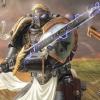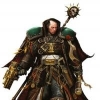Ragnar
Reaction: After your warlord commits to a planet with an enemy warlord, deal 2 damage to a target enemy unit at that planet.
Blackmane's Hunt
Reaction: After your warlord commits to a planet, commit your warlord to an adjacent planet.
Foresight
Reaction: After your warlord commits to a planet, commit it to a different planet.
Situation :
Ragnar commit to planet 1, Eldorath commit to planet 2.
Ragnar plays Blackmane's Hunt to recommit to planet 2.
The question is, can the Eldorath player trigger Foresight's reaction, or is he forced to react to the "recommitment" of Ragnar first, thus taking the 2 damage from Ragnar.
Some players from my meta suggested that all the reaction from Ragnar's commitment must be done before Eldorath's.
Their argument is this part from Rules References :
Nested Ability Sequences
Abilities generally resolve in a “first in, first out†manner. For instance, if a player has two reaction
abilities he wishes to trigger in reaction to a single triggering condition, the first reaction is triggered and resolved in its entirety, and then the second reaction is triggered and resolved.
• Interrupt and reaction effects may, however, cause new conditions that can initiate a subsequent series of interrupt and reaction abilities. Such abilities will nest on top of one another, creating a sequence of abilities, and these sequences need to be resolved in a “last in, first out†manner.
When such a sequence of abilities occurs, players should keep triggering abilities until the chain of
sequences runs dry (i.e. there are no interrupts or reactions to the resolution of all abilities from the
last ability triggered in the sequence).
• The most recently initiated nested ability sequence is always completely resolved before any former sequence of abilities is resolved.



 Sign In
Sign In Create Account
Create Account




 Back to top
Back to top





















